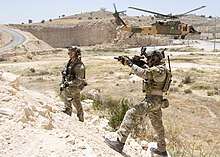Special operations
Special operations (S.O.) are military activities conducted by specially designated, organized, selected, trained, and equipped forces using unconventional techniques and modes of employment.[1][2]

Use and efficiency
United States
The decade 2003–2012 saw U.S. national security strategy rely on special operations to an unprecedented degree. Identifying, hunting, and killing terrorists became a central task in the Global War on Terrorism (GWOT). Linda Robinson, Adjunct Senior Fellow for U.S. National Security and Foreign Policy at the Council on Foreign Relations, argued that the organizational structure became flatter and cooperation with the intelligence community was stronger, allowing special operations to move at the "speed of war".[3] Special Operations appropriations are costly: Its budget went from $2.3 billion in 2001 to $10.5 billion in 2012.[3] Some experts argued the investment was worthwhile, pointing to the raid in May 2011 that killed Osama bin Laden in Abbottabad, Pakistan. Others claimed that the emphasis on Special Operations precipitated a misconception that it was a substitute for prolonged conflict. "Raids and drone strikes are tactics that are rarely decisive and often incur significant political and diplomatic costs for the United States. Although raids and drone strikes are necessary to disrupt dire and imminent threats…special operations leaders readily admit that they should not be the central pillar of U.S. military strategy."[3] Instead, Special Operations commanders stated that grand strategy should include their "indirect approach", which meant working with non-U.S. partners to accomplish security objectives. "Special Operations forces forge relationships that can last for decades with a diverse collection of groups: training, advising, and operation alongside other countries' militaries, police forces, tribes, militias or other information groups."[3]
See also
References
- North Atlantic Treaty Organization (13 December 2013). "Allied Joint Doctrine for Special Operations". NATO Standard Allied Joint Publication. Brussels: NATO Standardization Agency. AJP-3.5 (Edition A, Version 1): 1.
- North Atlantic Treaty Organization (17 November 2015). "NATO Glossary of Terms and Definitions (English and French)" (PDF). AAP-06 (Edition 2015). Brussels: NATO Standardization Agency: 2–S–8. Retrieved 18 September 2016. Cite journal requires
|journal=(help) - Robinson, Linda (November–December 2012). "The Future of Special Operations: Beyond Kill and Capture". Foreign Affairs. 91 (6): 110–122.
Further reading
- Capt. Malcolm Brailey, The Transformation of Special Operations Forces in Contemporary Conflict: Strategy, Missions, Organisation and Tactics. Canberra, ACT: Land Warfare Studies Centre, Working Paper No. 127, 2005.
- Colin S. Gray, “Part III: Strategy and Special Operations”, Explorations in Strategy. Westport, CT: Greenwood Press, 1996, pp. 139–232.
- William H. McRaven, Spec Ops: Case Studies of Special Operations Warfare; Theory and Practice. Novato, CA: Presidio, 1995.
- Linda Robinson, One Hundred Victories: Special Ops and the Future of American Warfare, New York: Public Affairs, 2013. ISBN 978-1-61039-149-8 .